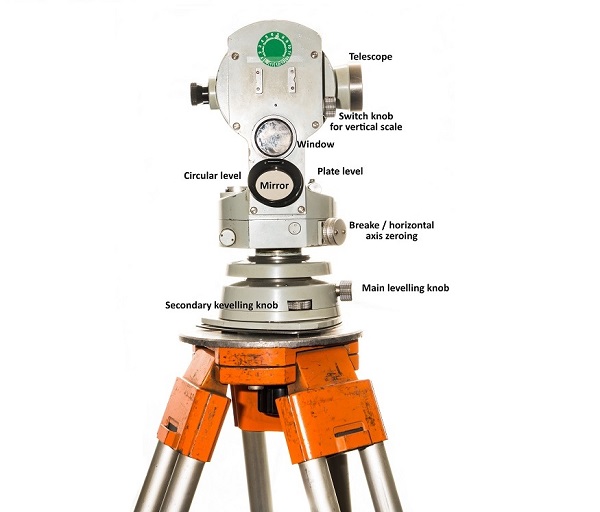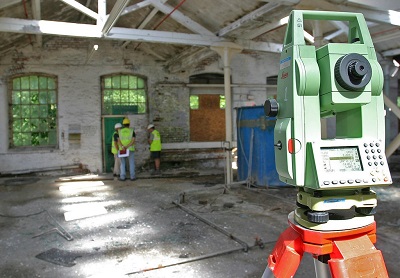Theodolite Instrument
Theodolite is a precision optical instrument which is used for measuring angles in the horizontal and vertical planes. It is mainly used for surveying applications. But it also used in other areas like metrology, rocket launch technology, level difference, curve setting, grades setting etc.
Theodolite Survey
Theodolite surveying is the branch of surveying in which theodolite instrument is used to measure the vertical and horizontal angles. By using compass we can only measure horizontal angles which gives less accuracy. But, by theodolite surveying we can measure both vertical and horizontal angles with greater accuracy.
Parts of Theodolite Diagram
Theodolite has so many important parts and all parts are used for adjustment of instrument. By using all parts we can minimize the errors and we can get greater accuracy results.
So it is very important to understand all the parts. Name of all parts are given below.
- Tripod
- Telescope
- Eye piece
- Object piece
- Plate level
- Upper plate
- Lower plate
- Horizontal circle
- Vertical circle
- Magnetic compass
- Levelling head
- Shifting head
- Plumb bob
- Index frame
- The standards
- Altitude bubble
- Levelling screw
- Trivet
- Tripod head
- Tripod leg
- Tangent screw
- Foot screw
- Inner spindle
- Outer spindle
- Vernier
Theodolite Diagram: Important Definitions
Telescope
Telescope is used for sighting the objects. It can be rotated in both vertical and horizontal directions. Telescope consists two convex lenses. Lens nearest to eye is called eye piece and lens nearest to object is called object piece.
Normal adjustment telescope
While taking the reading, if the vertical circle is left side of the observer, it is called telescope normal. It is also called as face left observation.
Telescope inverted
While taking the reading, if the vertical circle is right side of the observer, it is called telescope inverted. It is also called as face right observation.
True bearing
True bearing is the angle measured in clock wise direction from true meridian’s north. In surveying and air navigation a true bearing measures the angle with a fixed north-south line. It is a fixed angle and does not vary with time.
True bearing is an accurate way of measuring direction of any place in relation to another. It is more accurate than direction because it gives 360 degree points.
Magnetic bearing
Magnetic bearing is the angle measured in clock wise direction from magnetic meridian’s north. Its depend on magnetic field of the earth and its vary with time to time and place to place.
Fundamental axes of theodolite
Fundamental axes are used for Permanent adjustment of Instrument which deals with fundamental lines and their relationships.
Some Fundamental axes are given below.
Line of collimation
Line of collimation is an imaginary line which is passing through optical center of object glass and intersection of cross hairs at the diaphragm.
Line of sight
Line of collimation is also known as line of sight which is an imaginary line which is passing through optical center of object glass and intersection of cross hairs at the diaphragm.
Axis of bubble tube
Axis of bubble tube is a tangential line to curve of level tube. When bubble tube’s bubble is at center level, axis of bubble tube will be horizontal and parallel to the line of collimation or line of sight.
Methods of theodolite surveying
Here two methods are listed for measurement of horizontal angle.
Repetition method of theodolite surveying
Repetition method is used to improve the accuracy of horizontal angle measurement. In this method, same angle is measured multiple times with face left observation and face right observation. The arithmetic mean of these observations gives the final true value of angle.
This method is used when greater accuracy is required. For small survey works normal method of angle measurement is used.
By using this method error due to inaccurate bisection of the object, errors due to in adjustments of line of collimation, errors due to eccentricity, error due to inaccurate graduations can be eliminated.
Reiteration method of theodolite surveying
Reiteration method is used for horizontal angle measurement in which angles are measured successively starting from a point termed as an initial station. It is also called the Direction method or the Method of series.
It is used when several angles of well-distributed points/objects are to be measured from the same instrument station with high precision.
Adjustment of theodolite
It includes the temporary adjustment and permanent adjustment. Temporary adjustment is done at every stations, while permanent adjustment is done once.
Temporary adjustment and permanent adjustment are explain in detail below.
Temporary adjustment of theodolite
Temporary adjustment is a set of operations which are performed to make instrument ready for taking observations. Temporary adjustment is done at every station where instrument is set up.
It includes the following operations:
- Setting up of tripod and instrument
- Centering
- Levelling
- Focusing of eyepiece
- Elimination of parallax
- Focusing the objective
Permanent adjustment of theodolite
Permanent adjustment deal with fundamental lines and their relationships. It should be done once.
It includes the following operations:
- The line of collimation must be at a right angle to the horizontal axis.
- The axis of the telescope level must be parallel to the line of collimation.
- The axis of plate level must be perpendicular to the vertical axis.
- The horizontal axis must be perpendicular to the vertical axis.
Types of Theodolite
For surveying, various types of theodolites are used for various purposes likes some instruments are used for less accuracy, some are used for larger accuracy, some are used for specialized works, some are used for small scale mapping and some instruments are used for large scale mapping.
Some of them which are used mostly are given below.
Transit theodolite
It includes transit mechanism that allow the telescope to rotate about 180° in vertical plane about horizontal axis and lock into place when the instrument is level. That means directing the telescope in exact opposite direction.
For accurate measurement of horizontal angle transit mechanism is used. In this process, both face left and face right observation are taken and then average of both the observation is taken, it is considered as final true angle in horizontal angle measurement.
Non transit theodolite
It Not includes transit mechanism that allow the telescope to rotate about 180° in vertical plane about horizontal axis and lock into place when the instrument is level. That means we can not directing the telescope in exact opposite direction.
In this case telescope is fixed with instrument. We can not rotate the telescope in any direction.
Surveyors theodolite
It can be rotated about vertical and horizontal axis and it is used to measure horizontal and vertical angles. It gives high accuracy in angle measurements than compass.
It is generally used in large scale survey areas where higher accuracy is required. For large scale mapping we can not use compass, because it gives less accuracy.
It is also used in various areas likes level difference, road survey, railway survey, curve setting, grade setting, in tacheometric survey etc.
Total Station Theodolite
Total station is a combination of an electronic theodolite and electronic distance meter. It is mainly used by land surveyors and civil engineers for topographic survey, road surveys and land surveys.
Total station consists a EDM (Electronic distance measurement) to measure direct distance without using chain or a tape.
Total station is also used for coordinate measurement of unknown points related to points of known coordinates.
It also consists a electronic storage device with records the horizontal and vertical angle measurement readings and distance measurement readings.
Its gives very high accuracy and its price is also very high.
Optical theodolite
It is a precision instrument which is easy to use, lighter in weight and it gives higher accuracy as compared to other types. It consists Internal magnifying optical system and electronic readings.
It is used for all types of surveys like all small and large scale mapping and for geodetic surveys.
Micro optic theodolite
It is classified as a lower-order instrument which is used where higher accuracy is not required like small scale survey works. It consists a telescope of length 146 mm and its provide shortest allowable focusing distance of 1.6 m.
Electronic theodolite
It consists a electronic readout screen. This screen display readings of horizontal and vertical angle measurements. It also consists a optical plummet which ensures that instrument is placed as close to exactly vertical above the survey point or not.
It consists a electronic distance meter also, for accurate distance measurement without using any manual distance measurement instruments like tape or chain.
Vernier transit theodolite
It consists a vernier scale for accurate measurement of readings of horizontal angle as well as vertical angle and its includes transit mechanism that allow the telescope to rotate about 180° in vertical plane about horizontal axis.
Digital theodolite
It consists telescope that is mounted on a base and its also include electronic display and electromagnetic distance measurement device. It is used for high accuracy works and for larger scale surveys.
It consists a electronic display for readings, EDM for distance measurement, optical plummet for centering.
It is used for very high accuracy specialized purposes of works like meteorology and rocket launch technology.
Theodolite traversing in surveying
It is a method of field surveying which is used to establish control networks in which the traverse legs are measured by direct chaining method on ground and the traverse angle at every traverse station is measured with a theodolite instrument.
Types of traverse
1. Open traverse
Open traverse is series of connected lines which begins and ends at different locations and therefore does not completely enclose a polygon.
2. Closed traverse
Closed traverse is series of connected lines which begins and ends at same locations and therefore it completely enclose a polygon.
Methods of traversing
1. Theodolite traversing
Theodolite traversing is a method of field surveying which is used to establish control networks in which the traverse legs are measured by direct chaining method on ground and the traverse angle at every traverse station is measured with a theodolite instrument.
2. Compass traversing
Compass traversing is a method of field surveying which is used to establish control networks in which the traverse legs are measured by direct chaining method on ground and the traverse angle at every traverse station is measured with a compass.
Uses of theodolite in surveying
Theodolite is used for different purposes as listed below.
- For setting out grades
- For finding the difference in the level
- For measuring horizontal angle as well as vertical angles
- For tachometric surveying
- For prolonging survey lines
- For setting out of curves
- For specialized purposes like meteorology and rocket launch technology
- For electronic distance measurement
Horizontal angle measurement by theodolite
Horizontal angle measurement includes following procedure for angle ABC.
- At first the instrument is to be set over the station point B.
- Lower clamp is then kept fixed and upper clamp is loosened.
- Then vernier A is set to 0° and vernier B is set to 180°.
- The Upper clamp is then tightened and vernier A and B are set to 0° and 180°.
- Upper clamp is then kept fixed and lower clamp is loosened and bisect the ranging rod at A using telescope.
- The upper clamp is loosed and bisect the ranging rod at C by turning the telescope clockwise.
- Finally the reading on vernier A and B are noted. Which gives the angle between ABC.
Vertical angle measurement by theodolite
Vertical angle measurement includes following procedure.
- At first the instrument is to be set over the station point O.
- Set vernier of vertical circle at 0°.
- The telescope is then clamped.
- Then by using telescope bisect the vertical point A accurately.
- Then readings on both the verniers are noted and the angle of elevation is recorded.
- Now change the face of instrument.
- And again repeat the whole process.
- Then take average of two angles, which is final angle.
FAQs
What is theodolite ?
Theodolite is a precision optical instrument which is used for measuring angles in the horizontal and vertical planes. It is used for various purposes likes finding level difference, for setting out curves and for other specialized works.
What is transit and non transit theodolite ?
Transit theodolite includes transit mechanism that allow the telescope to rotate about 180° in vertical plane about horizontal axis and lock into place when the instrument is level. That means directing the telescope in exact opposite direction.
While non-transit theodolite not includes transit mechanism that allow the telescope to rotate about 180° in vertical plane about horizontal axis and lock into place when the instrument is level. That means we can not directing the telescope in exact opposite direction.
What is theodolite surveying ?
It is the branch of surveying in which theodolite instrument is used to measure the vertical and horizontal angles. By using compass we can only measure horizontal angles which gives less accuracy. But, by theodolite surveying we can measure both vertical and horizontal angles with greater accuracy.
Theodolite is an instrument used for ?
Theodolite is used for measuring angles in the horizontal and vertical planes. It is mainly used for surveying applications. But it also used in other areas like metrology, rocket launch technology, for setting out grades, for setting out curves, for level difference, for tacheometric survey, for large scale survey areas etc.
What is the difference between true bearing and magnetic bearing ?
True bearing is the angle measured in clock wise direction from true meridian’s north. It is a fixed angle and does not vary with time. While magnetic bearing is the angle measured in clock wise direction from magnetic meridian’s north. Its depend on magnetic field of the earth and its vary with time to time and place to place.
What is the theodolite price ?
Theodolite available in market are of different prices. Minimum price of one piece is 4000/- Rs. and maximum 150000/- Rs. Minimum price of one whole set is 14500/- Rs. and maximum 225000/- Rs.
What is theodolite and total station ?
Theodolite is a precision optical instrument which is used for measuring horizontal and vertical angles. While total station is a digital electronic instrument which consists a electronic display for readings, EDM for distance measurement, optical plummet for centering.
What is true bearing and magnetic bearing ?
True bearing is the angle measured in clock wise direction from true meridian’s north. In surveying and air navigation a true bearing measures the angle with a fixed north-south line. True bearing is an accurate way of measuring direction of any place in relation to another. It is more accurate than direction because it gives 360 degree points.
While magnetic bearing is the angle measured in clock wise direction from magnetic meridian’s north. Its depend on magnetic field of the earth and its vary with time to time and place to place.
What are the parts of a theodolite ?
Theodolite consists Tripod, Telescope, Eye piece, Object piece, Plate level, Upper plate, Lower plate, Horizontal circle, Vertical circle, Magnetic compass, Levelling head, Shifting head, Plumb bob, Index frame, The standards, Altitude bubble, Levelling screw, Trivet, Tripod head, Tripod leg, Tangent screw, Foot screw, Inner spindle, Outer spindle, Vernier etc. parts.
What are the uses of theodolite in surveying ?
Theodolite is used for different purposes like For electronic distance measurement, For setting out of curves, For tachometric surveying, For finding the difference in the level, For specialized purposes like meteorology and rocket launch technology, For prolonging survey lines, For measuring horizontal angle as well as vertical angles, For setting out grades etc.
Also Visit
➤ Civil Engineering Study Materials



